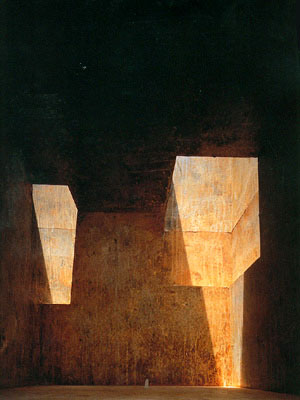Task: To be inspired by a few of Eduardo Chillida's artworks to create a concept model, then digitally manipulate a photograph of it into other photographs. We then made a flip book to explore the model's space.
The image which I selected: Mount Tindaya
During the first lesson, I found that the artwork is a cubic cave, 40x40x40m, to be excavated out of a mountain in the Canary Islands. To be, although the space is quite large, it feels like a restraint on freedom. I wanted to invert the light shafts, the solidity of the walls, the location. I wanted to explores 'space' and 'light' as my concept.
At the beginning of the task, I was quite confused at what we were supposed to do and how we were supposed to present the tasks. For clarity, I conducted research and wrote a 1000 word essay to order my thoughts and justify my concept of 'space'.
My concept model
As I have a long interesting in light, colour, the sky, and space - in terms of both astronomy and "an embodiment of place" ("Art and Space", Martin Heidegger 1969) - I tried to look for photographs that incorporated this kind of atmosphere to manipulated photographs of my concept model into.

New York Central Park at night. The image was taken with a 180 degree angle camera and I tried to conform to the two point perspesctive and lights, and emphasise the size of the model.
Once again, I tried to reflect the starry lights reflected on the perspex.
I thought using a snow image would be interesting as there is a compliment between the stark whiteness and the transparent model.
This image is also the field in Cental Park, however I have changed the scale so that the shape of the model can be seen. As the material is transparent, to make it look realistic, I had to play around with transparency and gaussian blur.
Flip book animation
To reflect the simplicity of the model, and still express realism, I made my poster layout basic and clean.
From this workshop, I have developed skills in photoshop and visually communicating ideas and concepts. I enjoyed this workshop as I was able to be more creative and challenge ideas such as whether 'space' is a concept or not. I found the flip book quite tiresome as it required just slight changes to ensure a smooth exploration of the space. Thus, I scanned in my drawn images and tweened between frames, something I have previously learned how to do in photoshop.













































